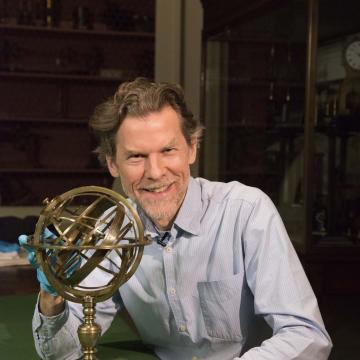Armillary sphere
Presented by Chris Parkin – Secondary Education Officer.
Inventory Number: 45453
Armillary spheres date back to the ancients, and were certainly used by the 2nd-century astronomer and mathematician Claudius Ptolemy of Alexandria. They were mathematical instruments designed to demonstrate the movement of the celestial sphere about a stationary Earth at its centre.

The concept of the celestial sphere was fundamental to astronomy from Antiquity through the Middle Ages and into the early Modern era.
At the centre of the sphere is the Earth. As the Earth is stationary in this model, it is the celestial sphere which rotates about it and acts as a reference system for locating the celestial bodies – stars, in particular – from a geocentric perspective.
It wasn’t until the middle of the 1500s CE that the basis of the instrument – a geocentric concept of the Universe – was seriously challenged by the Polish mathematician Nicolaus Copernicus. Even then, the instrument still continued to serve a useful purpose as a purely mathematical instrument.
How does an armillary sphere work?
https://www.youtube.com/embed/AaWuJHQL-bQ
Held stationary at the centre is a small brass sphere representing the Earth.
About it rotate a set of rings representing the heavens – the celestial sphere – with one complete revolution approximating 24 hours.
The sphere is mounted at the celestial poles that define the axis of rotation, and its structure includes an equatorial ring and, parallel to this, two smaller rings representing the Tropics of Cancer and Capricorn to the north and south, respectively.
Touching each of these circles, and crossing the celestial equator at points representing the equinoxes (equal hours of night and day), is the ecliptic circle or Zodiac ring. This ring represents the annual pathway of the Sun as, independently of the other stars, it makes its unique journey through the constellations of the Zodiac.

Portrait of Nicolas Copernicus, 1580
Each of the signs of the Zodiac is engraved upon the ecliptic ring, which is also calibrated with a calendar scale enabling the instrument to be used to model the apparent motion of the Sun and the stars at any time of the year. The instrument could be used not only to model the movements and relative geometry of the heavens, but to carry out all sorts of calculations, such as the times of sunrise and sunset, the length of a day, and the altitude of the Sun or stars.
Suspended within a ring, the sphere sits in a cradle mounted on an elegant tripod stand. The position of the ring can be adjusted for latitude within the cradle. At the top of the stand is another ring representing the celestial horizon. As the sphere rotates, anything above the horizon ring at any one time will, in theory, be visible in the heavens; anything below will be hidden.
Smaller armillary spheres such as this one were generally used for demonstration. Much larger armillary spheres were constructed for observation and measurement. These would have carried sights positioned opposite each other on pairs of rings to establish celestial coordinates.
This particular instrument is Italian, made in Rome in 1588, and is signed by Carlo Plato. It has a number of unusual features that make it rather special, such as the Moon mounted on a separate ring within the sphere, and a number of stars represented by individual pointers.





